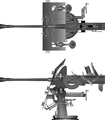German submarine U-1105
 U-995, the last remaining Type VIIC/41 U-boat and sister to U-1105 | |
| Career (Nazi Germany) | |
|---|---|
| Name: | U-1105 |
| Ordered: | 14 October 1941 |
| Builder: | Nordseewerke, Emden |
| Laid down: | 6 July 1943 |
| Launched: | 20 April 1944 |
| Commissioned: | 3 June 1944 |
| Fate: | Surrendered, 10 May 1945 |
| Career (UK) | |
| Name: | N-16 |
| Acquired: | 10 May 1945 |
| Fate: | Transferred to the US Navy, 1946 |
| Career (United States) | |
| Name: | U-1105 |
| Acquired: | 1946 |
| Fate: | Scuttled, 19 September 1949 |
| General characteristics | |
| Class and type: | Type VII-C/41 U-boat |
| Displacement: | 759 tonnes (747 long tons) surfaced 860 t (846 long tons) submerged |
| Length: | 67.10 m (220 ft 2 in) o/a 50.5 m (165 ft 8 in) pressure hull |
| Beam: | 6.2 m (20 ft 4 in) o/a 4.7 m (15 ft 5 in) pressure hull |
| Height: | 9.6 m (31 ft 6 in) |
| Draft: | 4.74 m (15 ft 7 in) |
| Propulsion: | Diesel-electric Diesel engines, 3,200 hp (2,386 kW) Electric motors, 750 hp (559 kW) |
| Speed: | 17.7 knots (32.8 km/h; 20.4 mph) surfaced 7.6 knots (14.1 km/h; 8.7 mph) submerged |
| Range: | 8,500 nmi (15,700 km; 9,800 mi) at 10 knots (19 km/h; 12 mph) surfaced 80 nmi (150 km; 92 mi) at 4 knots (7.4 km/h; 4.6 mph) submerged |
| Test depth: | 250 m (820 ft) |
| Complement: | 44-52 officers and enlisted men |
| Armament: | 1 × 88 mm/45 deck gun (220 rounds) 5 × 21 in (533 mm) torpedo tubes (4 bow, 1 stern) |
|
U-1105 BLACK Panther (Type VIIC German Submarine) | |
 | |
| Nearest city | Piney Point, Maryland |
|---|---|
| Coordinates | 38°8′10″N 76°33′10″W / 38.13611°N 76.55278°WCoordinates: 38°8′10″N 76°33′10″W / 38.13611°N 76.55278°W |
| Area | less than one acre |
| Built | 1944 |
| Architectural style | Other, Submarine Type VIIC |
| Governing body | Federal |
| NRHP Reference # | 00001602[1] |
| Added to NRHP | 11 January 2001 |
German submarine U-1105, a modified Type VII-C/41 U-boat of Nazi Germany's Kriegsmarine, was built at the Nordseewerke Shipyard, Emden, Germany, and commissioned into the Kriegsmarine on 3 June 1944. Oberleutnant zur See Hans-Joachim Schwarz was given command. He would command U-1105 for the duration of her German service.
Kriegsmarine
Service history
It was one of less than ten submarines that the Germans outfitted with experimental synthetic rubber skin of anechoic tiles designed to counter Allied sonar devices. Codenamed "Alberich," after a sorcerer from ancient Norse mythology, this top-secret rubber coating process ultimately contributed to the ship's survival under extreme combat conditions and earned it the name "Black Panther." For this reason, a black panther sprawled across the top of the globe was painted on U-1105's conning tower. U-boats with Alberich coating include: Type IIB — U-11; Type VIIC — U-480, U-485 and U-486; Type VIIC/41 — U-1105, U-1106, U-1107, U-1304, U-1306 and U-1308; Type XXIII — U-4704, U-4708 and U-4709.[2][3][4]
After trials in the Baltic Sea and final outfitting in Wilhelmshaven, the submarine began patrolling Allied convoy routes near Blackrock, Ireland in the spring of 1945. In April, U-1105 escaped detection by an Allied destroyer patrol. Days later, the U-boat detected three British destroyers that were part of the Second Division of the 21st Escort Group. The submarine fired two acoustic torpedoes at a range of 2000 meters and then dove to 100 meters to escape a counterattack. Fifty seconds passed before the first torpedo struck, with the second hitting just moments later. Thirty-two crewmen from U-1105's victim, HMS Redmill, were lost. The Allied search for U-1105 and the search for Redmill's survivors began immediately. The submarine, unable to maintain its 330-foot depth, sank to the bottom at 570 feet, remaining motionless. For the next 31 hours, the Allied squadron searched for the U-boat without success. U-1105 evaded detection for the remainder of the Second World War.
On 4 May 1945, U-1105 received the last order from Großadmiral Karl Dönitz: the war is over. Ironically, the submarine surrendered to the 21st Escort Group, the same escort group it attacked just a few weeks earlier. Ordered to the surface, the submarine proceeded to the Allied base at Loch Eriboll, Scotland on 10 May 1945 to surrender.
Summary of raiding career
| Date | Ship | Nationality | Tonnage | Fate |
|---|---|---|---|---|
| 27 April 1945 | HMS Redmill | 1,300 | Total Loss |
Royal Navy
Though still operated by her German crew, U-1105 was redesignated as the Royal Navy submarine N-16 and sailed under armed frigate and air escort along with other surrendered U-boats, through the North Minch to the British naval base at Lochalsh, then to Lisahally, Northern Ireland. Given a British caretaker crew she sat at Lishally for several months before she was turned over to the United States as a war prize for study of its unique synthetic rubber skin.
United States Navy
In 1946, redesignated U-1105, the U-boat arrived in Portsmouth, New Hampshire. The Naval Research Laboratory in Washington, D.C., and Massachusetts Institute of Technology's Acoustic Laboratory in Cambridge, Massachusetts, conducted research on its unique rubber-tiled skin. After the research was completed, the boat was towed to Solomon's Island, Maryland for explosives testing.
USS Salvager and USS Windlass were assigned to tow U-1105 into Chesapeake Bay where she was temporarily sunk. Salvage and towing tests were conducted from 10–25 August. Moored on 29 September to allow pontoons to be fixed to her sides, U-1105 underwent another series of salvage and towing tests until 18 November, when she was sunk off Point No Point Light and buoys were left to mark the spot.
In the summer of 1949 U-1105 was raised again and towed into the Potomac River and anchored off Piney Point, Maryland for preparations for her final demolition. On 19 September 1949, a 250 lb. MK.6 depth charge was detonated 30 feet from U-1105. After being lifted out of the water, she went down one last time in more than 91 feet of water landing upright, her pressure hull cracked open by the explosion all the way around to the keel. Little evidence was left to mark the wreck, so for the next 36 years the submarine was lost to history.
The wreck
On 29 June 1985, the wreck of U-1105 was discovered by a team of sport divers led by Uwe Lovas, approximately one mile west of Piney Point, Maryland, at 38°08′10″N 76°33′10″W / 38.13611°N 76.55278°W. In November 1994, it was designated as Maryland's first historic shipwreck preserve. The program, the first of its kind in the state, was designed to promote the preservation of historic shipwreck sites while making them accessible to the general public.
At the wreck site, the conning tower rises to within 68 feet of the surface. The wood covered main deck fore and aft of the conning tower is occasionally exposed by the drifting silt beds. The wreck is well preserved, and largely intact. Seasonally, thick layers of marine growth appear and then disappear on the site, often covering structural features. Between April and December, a large blue and white mooring buoy is anchored about 70 feet from the wreck, while a small, orange ball float is anchored to the stump of the forward (air-search) periscope.
The site is maintained for the Maryland Historical Trust by the Institute of Maritime History, and was placed on the National Register of Historic Places in 2001.[1]
Armament
FLAK weaponry
U-1105 was mounted with a single 3.7 cm Flakzwilling M43U gun on the LM 42U mount. The LM 42U mount was the most common mount used with the 3.7 cm Flak M42U. The 3.7 cm Flak M42U was the marine version of the 3.7 cm Flak used by the Kriegsmarine on Type VII and Type IX U-boats.
-

A single 3.7 cm Flak M42U gun on the LM 42U mount.
See also
- Battle of the Atlantic (1939-1945)
References
- ↑ 1.0 1.1 "National Register Information System". National Register of Historic Places. National Park Service. 2010-07-09.
- ↑ Wynn, Kenneth G. U-Boat Operations of the Second World War: Career Histories, U1-U510. Naval Institute Press (March 1998). ISBN 1-55750-860-7.
- ↑ Rèossler, Eberhard. Die Sonaranlagen Der Deutschen Unterseeboote: Entwicklung, Erprobung, Einsatz Und Wirkung Akustischer Ortungs- Und Tauschungseinrichtungen Der Deutschen Unterseeboote. Bernard & Graefe. ISBN 3-7637-6272-8
- ↑ "Recubrimiento Anti-Sonar". u-historia.com. Retrieved 17 December 2010.
Bibliography
- Gröner, Erich (1985). U-Boote, Hilfskreuzer, Minenschiffe, Netzleger, Sperrbrecher. Die deutschen Kriegsschiffe 1815-1945 (in German) III (Koblenz: Bernard & Graefe). ISBN 3-7637-4802-4.
- Busch, Rainer; Röll, Hans-Joachim (1999). Deutsche U-Boot-Verluste von September 1939 bis Mai 1945. Der U-Boot-Krieg (in German) IV (Hamburg; Berlin; Bonn: Mittler). ISBN 3-8132-0514-2.
External links
- Hofmann, Markus. "U 1105". Deutsche U-Boote 1935-1945 - u-boot-archiv.de (in German). Retrieved 30 January 2015.
- Helgason, Guðmundur. "The Type VIIC/41 boat U-1105". German U-boats of WWII - uboat.net. Retrieved 8 December 2014.
- history.navy.mil: U-1105
- Maryland Historical Trust U-1105
- U-1105 "Black Panther", Saint Mary's County, including undated photo, at Maryland Historical Trust
- US Navy Conservation Site
- Institute of Maritime History Site
| |||||||||||||||||||||||||

